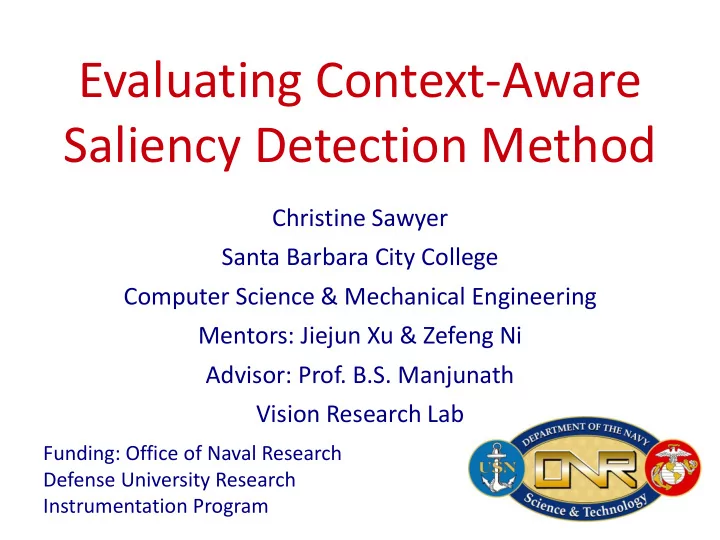

Evaluating Context-Aware Saliency Detection Method Christine Sawyer Santa Barbara City College Computer Science & Mechanical Engineering Mentors: Jiejun Xu & Zefeng Ni Advisor: Prof. B.S. Manjunath Vision Research Lab Funding: Office of Naval Research Defense University Research Instrumentation Program
What is Visual Saliency?
What is Visual Saliency? • Visual Saliency – Subjective perceptual quality which makes certain items stand out more than others.
What is Visual Saliency? • Visual Saliency – Subjective perceptual quality which makes certain items stand out more than others. • Mimic human perception Original Image Human Fixations Bruce et al.
Learning gaze patterns by tracking eye movement Using EyeLink1000 as a tool - High Speed Infrared Camera - Illuminator
Learning gaze patterns by tracking eye movement Using EyeLink1000 as a tool - High Speed Infrared Camera - Illuminator
Learning gaze patterns by tracking eye movement Using EyeLink1000 as a tool - High Speed Infrared Camera - Illuminator • Potential applications - Image Segmentation - Image Retargeting - Image Search & Retrieval
Learning gaze patterns by tracking eye movement Using EyeLink1000 as a tool - High Speed Infrared Camera - Illuminator • Potential applications - Image Segmentation - Image Retargeting - Image Search & Retrieval
Looking at the context of an image
Looking at the context of an image • Sometimes looking just dominant object is not enough.
Looking at the context of an image • Sometimes looking just dominant object is not enough. • Context-Aware Saliency - Extract salient object with its surroundings that add meaning to image.
Context-Aware Saliency Detection • 4 basic principles of human visual attention [Goferman et al.]
Context-Aware Saliency Detection • 4 basic principles of human visual attention • Use eye tracker to evaluate algorithm – What do people look at to determine the scenario of image? [Goferman et al.]
Context-Aware Saliency Detection • 4 basic principles of human visual attention • Use eye tracker to evaluate algorithm – What do people look at to determine the scenario of image? – Viewing Time – Categories [Goferman et al.]
The effects in lengths of time 2 Seconds
The effects in lengths of time • In depth analysis - Dominant object - Surroundings 2 Seconds 5 Seconds
How categories affects how you look • Sports – Person(s) participating – Sports equipment
How categories affects how you look • Sports – Person(s) participating – Sports equipment
Insight from preliminary experiments • Need to give test participants a specific task – People aimlessly search images when given no task. – People get distracted based on prior knowledge.
Insight from preliminary experiments • Need to give test participants a specific task – People aimlessly search images when given no task. – People get distracted based on prior knowledge.
Insight from preliminary experiments • Need to give test participants a specific task – People aimlessly search images when given no task. – People get distracted based on prior knowledge. • Time constraints – 4 seconds
Experimental Process • 60 images from various categories shown for 4 seconds to each of the 17 viewers.
Experimental Process • 60 images from various categories shown for 4 seconds to each of the 17 viewers.
Experimental Process • 60 images from various categories shown for 4 seconds to each of the 17 viewers. • Task: Look at the parts that best describe the image and give brief description of scene.
Experimental Process • 60 images from various categories shown for 4 seconds to each of the 17 viewers. • Task: Look at the parts that best describe the image and give brief description of scene. • Goal: Evaluate Context-Aware Saliency and create a data set that can provide ground truth data.
Categories of Results • Algorithm matches human perception • Algorithm partially matches human perception • Algorithm does not match human perception
Algorithm matches human perception • Image has simple background • Salient portion(s) have distinct differences in color and/or texture Original Image Context-Aware Saliency Algorithm
Experiment Results
Matching human perception
Matching human perception
Matching human perception
Algorithm misses part of the salient portion • Image has simple foreground – People look more at high level features like faces – The salient portion could be a similar color and/or texture as its surroundings Original Image Context-Aware Saliency Algorithm
Experiment Results
Partially matching human perception
Partially matching human perception
Partially matching human perception
Algorithm differs from human perception • The image is very busy • The dominant object is not obvious Original Image Context-Aware Saliency Algorithm
Experiment Results
Contrasting human perception
Contrasting human perception
Contrasting human perception
Conclusion and Future Plans • Match to human perception – Simple background and distinct foreground • Partial match to human perception – Plain foreground with more complex background • Contrast to human perception – Busy image – Unclear main object
Conclusion and Future Plans • Match to human perception – Simple background and distinct foreground • Partial match to human perception – Plain foreground with more complex background • Contrast to human perception – Busy image – Unclear main object • Effects of... – Blurring and noise in image – People's prior knowledge/background
References [1] Stas Goferman, Lihi Zelnik-Manor, and Ayellet Tal, "Context-Aware Saliency Detection", IEEE International Conference on Computer Vision and Pattern Recognition, 2010 [2] Wei Wang1,3,4, Yizhou Wang1,2, Qingming Huang1,4, Wen Gao, “Measuring Visual Saliency by Site Entropy Rate”, IEEE International Conference on Computer Vision and Pattern Recognition, 2010 [3] L. Itti, C. Koch, and E. Niebur. A model of saliency based visual attention for rapid scene analysis. IEEE TPAMI, 1998 [4] N.D. Bruce and J. Tsotsos. Saliency based on information maximization. NIPS, 2006 [5] J. Harel, C. Koch, and P. Perona. Graph-based visual saliency. NIPS, 2006 [6] X. Hou and L. Zhang. Dynamic visual attention: searching for coding length increments. NIPS, 2008
Acknowledgements • INSET • Prof. Manjunath • Jiejun Xu & Zefeng Ni • Vision Research Lab • Volunteers for my experiment • Professors, Family, & Friends
Recommend
More recommend